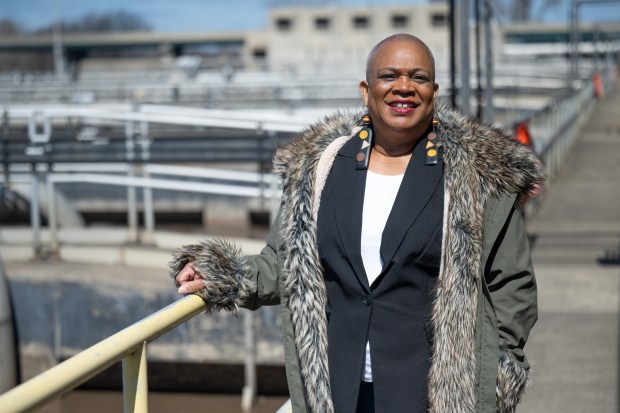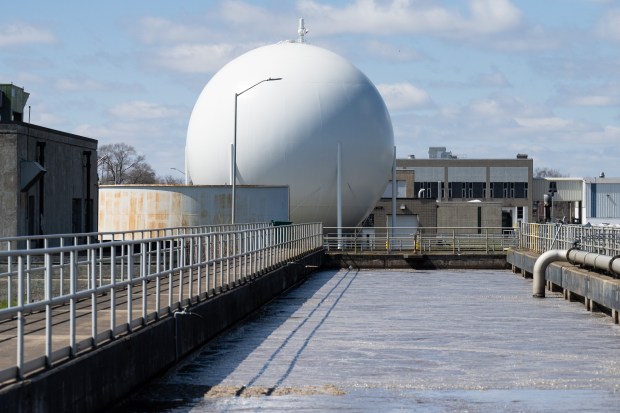Growing up in the 1970s, young Rhonda Brady always had a fascination for math and science – fields not generally welcoming for women.
In junior high, she made a discovery not found in her books, but on the school track.
Brady could run and jump. Really well.
She finished her first season undefeated in the 100-meter hurdles on the Lake Ridge Junior High boys’ track team. There was no girls’ team in the days before Title IX.
It didn’t stop Brady, who quickly understood the calculus of track success equating to a college scholarship.
After an impressive track career led her to the 1976 Montreal Olympics as the youngest member of the U.S. track team, Brady, now Rhonda Anderson, followed her first love of science and settled back in Gary to raise her two children.
She’s tracking sewage these days as executive director of the Gary Sanitary District, the state’s second-largest wastewater facility that spans 55 acres along the Grand Calumet River and the Indiana Toll Road. She’s the GSD’s third woman director.
Success on the track came too fast. She didn’t medal in Montreal and acknowledged her youth hurt her on the international stage.
“I was just overwhelmed,” she said.
She also captured three straight AAU Junior hurdles championships from 1975-77, but injuries hobbled and eventually ended her career.
Her track skills led her to Tennessee State University where she earned an undergrad degree in biology and then a master’s in biology from Purdue University.
Her road to college began with a rebellious fellow female athlete in the Lake Ridge Schools, just west of Gary.
“This was before Title IX, and it became more of a political statement by me and some classmates unhappy so many opportunities were there for boys, but not for us,” Anderson remembered.
“We thought we’d get the attention of somebody.”
They got the eye of Gary Mayor Richard G. Hatcher and they joined Hatcher’s Youth Foundation, created to give opportunities to young girls.
“It was life-changing,” said Anderson. “We went all over the country and got a lot of attention.”

Her success in junior and senior AAU national events qualified her for the U.S. Olympic track team. It would be another 40 years before a 16-year-old made the U.S. team. Another hurdler, Sydney McLaughlin-Levrone, did it in 2016.
When a ruptured Achilles tendon, plantar fasciitis and other injuries derailed her track career, Anderson again turned her focus to science and began leaving track behind.
“I just wasn’t able to get back to where I was previously,” after a serious injury in the NCAA track nationals, she said.
Her first job after grad school was at the Gary Sanitary District in a lab.
Later, she worked in a University of Illinois-Chicago molecular genetics lab mutating mouse cells, cloning DNA and sequencing it.
She spent the next two decades and rose to production superintendent at the Indiana-American Water Co., then known as the Gary-Hobart Water Co.
She couldn’t give up her love for track and coached the Lew Wallace girls’ track team for a decade, becoming one of Indiana’s most successful coaches.
Under Anderson, Wallace won three state girls’ track championships in 1992, 1993 and 1994.
Her coaching was a high mark in her career, she said. And her athletes called her an inspiration and a tough coach.
“She’s very knowledgeable about techniques, she’s fierce,” said Angela Hamblin-Blakely, a 1994 graduate and All-American basketball player and three-year starter at the University of Iowa.
“She was amazing, she knew her stuff and she pushed us to work hard and be the best we could be on the track.”
Anderson led a life as a track coach, in a lab and as a mom. Her daughter is an ICU nurse and her son graduated from Ball State and works in Portage.

In 2013, she received a phone call from new Gary Mayor Karen Freeman-Wilson who offered her a job as plant superintendent at the GSD. She would become the first woman to serve in that role.
“Rhonda Anderson had the credentials and ability to run the plant,” said Freeman-Wilson.
“Her degrees demonstrated that she was literally a rocket scientist who knew how to explain the complexities of our wastewater treatment plant.”
It’s a field dominated by men. Out of the 40 workers Anderson supervised, four were women.
“There was some resistance because of my lack of wastewater operating experience,” Anderson said of her early months.
“I learned the treatment process and wastewater was way more interesting and complicated than drinking water.”
Anderson mostly worked under former GSD executive director Dan Vicari, who now holds the same title at the Gary/Chicago International Airport. Vicari later joined the GSD Board of Commissioners and nominated Anderson to be executive director following the retirement of Charles “Spike” Peller last October.
During a tour of the massive sewage treatment plant, Anderson evokes a deep knowledge of the inner workings of sewage treatment that most people don’t imagine when they flush the toilet.
“This is where the magic happens,” she said while detailing the work of aerators, blowers, bacteria, clarifiers and digesters. The plant treats an average of 48 million gallons a day, Anderson said.
A heavy rainfall puts everyone in the plant on high alert as they calculate and react to stopping sewage and stormwater from being discharged into the Grand Calumet River, which feeds into Lake Michigan.
In addition to treating sewage for Gary, Hobart, Merrillville and Lake Station, the GSD also oversees trash pickup, street sweeping and E. coli testing at Lake Michigan beaches.
“Mayor (Eddie) Melton is adamant on us prioritizing projects to alleviate flooding,” she said in explaining the role of street sweepers to keep sediment out of the sewers.
Reflecting back on a life on the track and in science, Anderson is still amazed.
“I never thought I’d end up in a sewage treatment plant,” she said with a laugh as she explained the merits of sludge in creating bacteria.
Carole Carlson is a freelance reporter for the Post-Tribune.





